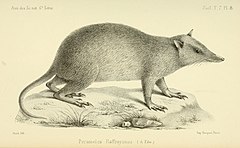Torboszczury
| Peroryctinae | |||
| Groves & Flannery, 1990[1] | |||
 Przedstawiciel podrodziny – torboszczur ciemny (P. raffrayana) na ilustracji z 1878 roku | |||
| Systematyka | |||
| Domena | |||
|---|---|---|---|
| Królestwo | |||
| Typ | |||
| Podtyp | |||
| Gromada | |||
| Podgromada | |||
| Nadrząd | |||
| Rząd | |||
| Rodzina | |||
| Podrodzina |
torboszczury | ||
| Typ nomenklatoryczny | |||
|
Perameles raffrayana Milne-Edwards, 1878 | |||
| Synonimy | |||
| |||
| Rodzaje i Gatunki | |||
| |||
Torboszczury[6] (Peroryctinae) – monotypowa podrodzina ssaków z rodziny jamrajowatych (Peramelidae).
Zasięg występowania[edytuj | edytuj kod]
Podrodzina obejmuje gatunki występujące na Nowej Gwinei[7][8][9].
Morfologia[edytuj | edytuj kod]
Długość ciała 27,5–55,8 cm, długość ogona 9,5–22,9 cm; masa ciała 0,65–4,9 kg; samce są większe i cięższe od samic[8][10].
Systematyka[edytuj | edytuj kod]
Rodzaj zdefiniował w 1906 roku angielski zoolog Oldfield Thomas na łamach Proceedings of the Zoological Society of London[5]. Jako gatunek typowy Thomas wyznaczył torboszczura ciemnego (P. raffrayana).
Etymologia[edytuj | edytuj kod]
- Peroryctes: gr. πηρα pēra „kieszeń, torba”[11]; oρυκτης oruktēs „kopacz”, od ορυσσω orussō „kopać”[12].
- Lemdubuoryctes: Lemdubu, Wyspy Aru, Indonezja; gr. ορυκτης oruktēs „kopacz”[4]. Gatunek typowy: †Lemdubuoryctes aruensis Kear, Aplin & Westerman, 2016.
Podział systematyczny[edytuj | edytuj kod]
Do podrodziny należy jeden rodzaj torboszczur[6] z następującymi występującymi współcześnie gatunkami[13][7][6]:
- Peroryctes broadbenti (Ramsay, 1879) – torboszczur większy
- Peroryctes raffrayana (Milne-Edwards, 1878) – torboszczur ciemny
Opisano również wymarły gatunek z plejstocenu–holocenu indonezyjskiej wyspy Kobroor[4][14]:
- Peroryctes aruensis (Kear, Aplin & Westerman, 2016)
Uwagi[edytuj | edytuj kod]
Przypisy[edytuj | edytuj kod]
- ↑ a b C.P. Groves & T. Flannery: Revision of the families and genera of bandicoots. W: J.H. Seebeck, R.L. Wallis, P.R. Brown & C.M. Kemper: Bandicoots and bilbies. Sydney: Surrey Beatty and Sons Pty. Ltd., 1990, s. 2. ISBN 978-0-949324-33-7. (ang.).
- ↑ M. Archer, H. Godthelp, S.J. Hand & D. Megirian. Fossil mammals of Riversleigh, northwestern Queensland: Preliminary overview of biostratigraphy, correlation and environmental change. „Australian Zoologist”. 25 (2), s. 32, 1989. DOI: 10.7882/AZ.1989.001. (ang.).
- ↑ M.C. McKenna & S.K. Bell: Classification of mammals above the species level. Nowy Jork: Columbia University Press, 1997, s. 57. ISBN 978-0-231-11013-6. (ang.).
- ↑ a b c B.P. Kear, K.P. Aplin & M. Westerman. Bandicoot fossils and DNA elucidate lineage antiquity amongst xeric-adapted Australasian marsupials. „Scientific Reports”. 6 (37537), s. 3, 2016. DOI: 10.1038/srep37537. (ang.).
- ↑ a b O. Thomas. On mammals collected in south-west Australia for Mr. W.E. Balston. „Proceedings of the Zoological Society of London”. 76 (3–4), s. 476, 1906. (ang.).
- ↑ a b c d W. Cichocki, A. Ważna, J. Cichocki, E. Rajska-Jurgiel, A. Jasiński & W. Bogdanowicz: Polskie nazewnictwo ssaków świata. Warszawa: Muzeum i Instytut Zoologii PAN, 2015, s. 10. ISBN 978-83-88147-15-9. (pol. • ang.).
- ↑ a b C.J. Burgin, D.E. Wilson, R.A. Mittermeier, A.B. Rylands, T.E. Lacher & W. Sechrest: Illustrated Checklist of the Mammals of the World. Cz. 1: Monotremata to Rodentia. Barcelona: Lynx Edicions, 2020, s. 72. ISBN 978-84-16728-34-3. (ang.).
- ↑ a b Ch. Dickman: Family Peramelidae (Bandicoots and Echymiperas). W: D.E. Wilson & R.A. Mittermeier (redaktorzy): Handbook of the Mammals of the World. Cz. 5: Monotremes and Marsupials. Barcelona: Lynx Edicions, 2015, s. 393. ISBN 978-84-96553-99-6. (ang.).
- ↑ D.E. Wilson & D.M. Reeder (redaktorzy): Genus Peroryctes. [w:] Mammal Species of the World. A Taxonomic and Geographic Reference (Wyd. 3) [on-line]. Johns Hopkins University Press, 2005. [dostęp 2020-10-24].
- ↑ Class Mammalia. W: Lynx Nature Books (A. Monadjem (przedmowa) & C.J. Burgin (wstęp)): All the Mammals of the World. Barcelona: Lynx Edicions, 2023, s. 50–51. ISBN 978-84-16728-66-4. (ang.).
- ↑ Jaeger 1944 ↓, s. 166.
- ↑ Jaeger 1944 ↓, s. 157.
- ↑ N. Upham, C. Burgin, J. Widness, M. Becker, C. Parker, S. Liphardt, I. Rochon & D. Huckaby: Treeview of Mammalian Taxonomy Hierarchy. [w:] ASM Mammal Diversity Database (Version 1.11) [on-line]. American Society of Mammalogists. [dostęp 2023-07-29]. (ang.).
- ↑ K.J. Travouillon & M.J. Phillips. Total evidence analysis of the phylogenetic relationships of bandicoots and bilbies (Marsupialia: Peramelemorphia): reassessment of two species and description of a new species. „Zootaxa”. 4378 (2), s. 224–256, 2018. DOI: 10.11646/zootaxa.4378.2.3. (ang.).
Bibliografia[edytuj | edytuj kod]
- Edmund C. Jaeger, Source-book of biological names and terms, wyd. 1, Springfield: Charles C. Thomas, 1944, s. 1-256, OCLC 637083062 (ang.).
